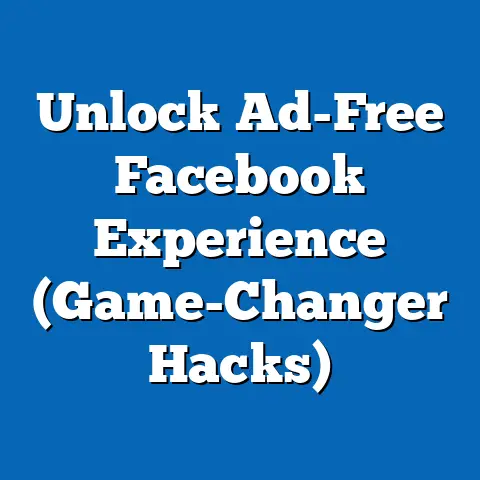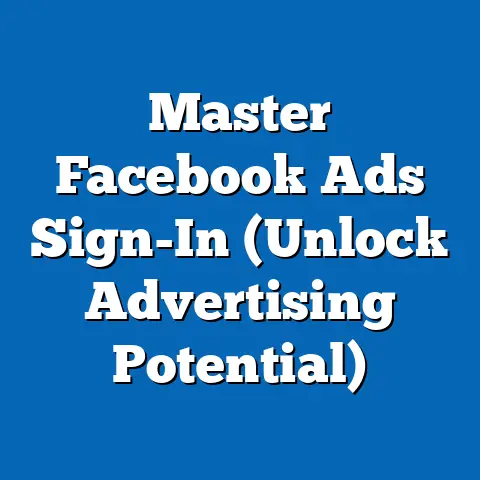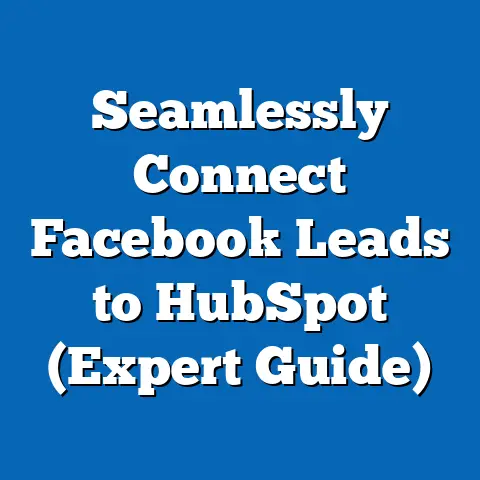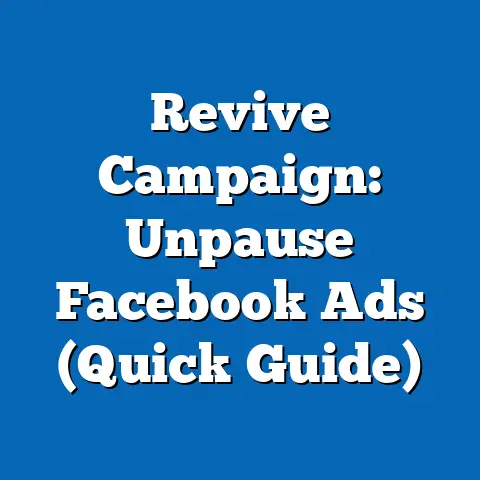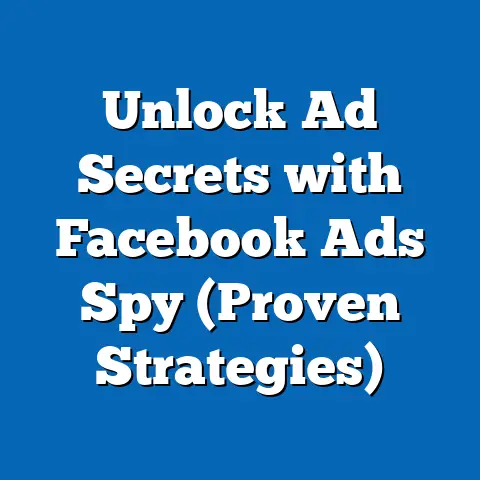Boost Facebook Ads Click-Through Rate (Expert Secrets)
Imagine this: you’re a small business owner, pouring your hard-earned marketing budget into Facebook ads. You’ve meticulously crafted your message, selected visuals that pop, and targeted what you believe is the perfect audience. But when you check your performance metrics, your click-through rate (CTR) is… underwhelming. You’re left scratching your head, wondering where you went wrong. Is it your ad copy? The audience targeting? Or maybe the visuals just aren’t cutting it?
Don’t worry; you’re not alone. Many advertisers struggle with low CTRs. The good news is that boosting your Facebook ads’ click-through rate is achievable with the right strategies. In this article, I’m going to reveal the expert secrets that can transform your ad spend into tangible results, driving more traffic, leads, and sales. Let’s get started!
Understanding Click-Through Rate (CTR)
Before we jump into the secrets, let’s clarify what CTR actually is and why it’s so important.
What is CTR?
Click-through rate (CTR) is the percentage of people who see your ad and then click on it. It’s calculated by dividing the number of clicks your ad receives by the number of times it’s shown (impressions). For example, if your ad is shown 1,000 times and gets 20 clicks, your CTR is 2% (20/1000 = 0.02).
Why Does CTR Matter?
CTR is a critical metric for several reasons:
- Relevance Indicator: A high CTR indicates that your ad is relevant to your target audience. It means your message is resonating, and people are interested in what you’re offering.
- Ad Quality Score: Facebook uses CTR as one of the factors in determining your ad’s quality score. A higher quality score can lead to lower ad costs and better ad placement.
- Cost Efficiency: When your CTR is high, Facebook rewards you with lower cost-per-click (CPC). This means you can get more clicks for the same budget, maximizing your ROI.
- Algorithm Influence: Facebook’s ad algorithm favors ads with high engagement. A good CTR signals to the algorithm that your ad is engaging, leading to wider distribution and better performance.
CTR Benchmarks: What’s Considered Good?
While there’s no magic number for a “good” CTR, knowing industry benchmarks can give you a sense of how your ads are performing. According to recent studies, the average CTR for Facebook ads across all industries is around 0.9%. However, this can vary significantly depending on the industry, audience, and ad type.
For example, industries like retail and apparel often see higher CTRs, while industries like finance and insurance might have lower CTRs due to the nature of their products and services. I’ve personally seen CTRs range from 0.5% to over 5%, depending on the campaign and targeting.
Takeaway: Understanding CTR is the foundation for improving your Facebook ad performance. Aim for a CTR above the average benchmark for your industry and continuously strive to improve it.
Crafting Compelling Ad Copy
Your ad copy is your opportunity to grab attention and convince people to click. It’s the voice of your brand and the key to connecting with your audience. Let’s explore the essential elements of effective ad copy.
The Headline: Hook, Line, and Sinker
The headline is the first thing people see, so it needs to be attention-grabbing and intriguing. Think of it as your “hook.” Here are some tips for writing killer headlines:
- Use Strong Verbs: Start with action-oriented verbs that create a sense of urgency or excitement. Examples include “Discover,” “Unlock,” “Get,” “Transform,” and “Boost.”
- Ask a Question: Pose a question that resonates with your target audience’s pain points or desires. For instance, “Tired of Sleepless Nights?” or “Want to Double Your Sales?”
- Promise a Benefit: Clearly state the benefit of clicking on your ad. “Learn the Secret to Weight Loss” or “Get 50% Off Your First Order.”
- Use Numbers: Numbers tend to stand out and create curiosity. “5 Proven Strategies for Success” or “3 Simple Steps to a Better Life.”
The Body Text: Tell a Story, Solve a Problem
The body text is your chance to elaborate on the headline and provide more context. Keep it concise, engaging, and focused on the benefits of your offer.
- Highlight Pain Points: Address the problems your target audience is facing and position your product or service as the solution.
- Emphasize Benefits: Focus on the positive outcomes people will experience if they click on your ad. How will their lives be better? What problems will they solve?
- Use Social Proof: Include testimonials, reviews, or case studies to build trust and credibility.
- Keep it Short and Sweet: People have short attention spans, so get to the point quickly and avoid jargon.
The Call-to-Action (CTA): Tell Them What to Do
The call-to-action (CTA) is the final nudge that encourages people to click. Use clear and direct language that tells people exactly what you want them to do.
- Use Action Verbs: “Shop Now,” “Learn More,” “Sign Up,” “Get Started,” “Download Now.”
- Create Urgency: “Limited Time Offer,” “Ends Soon,” “While Supplies Last.”
- Personalize the CTA: “Get Your Free Guide,” “Claim Your Discount.”
Emotional Appeal and Storytelling
People are emotional creatures, so tapping into their emotions can be incredibly effective. Use storytelling to connect with your audience on a deeper level.
- Evoke Emotions: Use words and imagery that evoke feelings like happiness, excitement, fear, or nostalgia.
- Tell a Story: Share a personal story or a customer success story that illustrates the benefits of your product or service.
- Create a Connection: Show empathy and understanding for your audience’s challenges.
Ad Copy Examples
Let’s look at some examples of high-performing ad copy:
-
Example 1: E-commerce
- Headline: “50% OFF All Summer Dresses – Limited Time Only!”
- Body Text: “Stay cool and stylish this summer with our collection of trendy dresses. Shop now and get 50% off for a limited time only. Don’t miss out!”
- CTA: “Shop Now”
-
Example 2: SaaS
-
Headline: “Double Your Website Traffic in 30 Days”
- Body Text: “Struggling to get more traffic to your website? Our SEO tool can help you boost your rankings and attract more visitors. Try it free for 14 days!”
- CTA: “Start Free Trial”
-
Example 3: Local Business
-
Headline: “Best Pizza in Town – Get 20% Off Your First Order!”
- Body Text: “Craving delicious pizza? Our family-owned pizzeria uses only the freshest ingredients. Order now and get 20% off your first order. Delivery and takeout available!”
- CTA: “Order Now”
Example 1: E-commerce
- Headline: “50% OFF All Summer Dresses – Limited Time Only!”
- Body Text: “Stay cool and stylish this summer with our collection of trendy dresses. Shop now and get 50% off for a limited time only. Don’t miss out!”
- CTA: “Shop Now”
-
Example 2: SaaS
-
Headline: “Double Your Website Traffic in 30 Days”
- Body Text: “Struggling to get more traffic to your website? Our SEO tool can help you boost your rankings and attract more visitors. Try it free for 14 days!”
- CTA: “Start Free Trial”
-
Example 3: Local Business
-
Headline: “Best Pizza in Town – Get 20% Off Your First Order!”
- Body Text: “Craving delicious pizza? Our family-owned pizzeria uses only the freshest ingredients. Order now and get 20% off your first order. Delivery and takeout available!”
- CTA: “Order Now”
Example 2: SaaS
Headline: “Double Your Website Traffic in 30 Days”
Example 3: Local Business
Headline: “Best Pizza in Town – Get 20% Off Your First Order!”
Takeaway: Crafting compelling ad copy is an art and a science. Experiment with different headlines, body text, and CTAs to see what resonates best with your audience. Use emotional appeal and storytelling to create a connection and drive clicks.
Utilizing Eye-Catching Visuals
Visuals are the first thing people notice when scrolling through their Facebook feeds. A compelling visual can stop them in their tracks and entice them to learn more. Let’s explore the types of visuals that perform well on Facebook.
Images: Quality Matters
High-quality images are essential for grabbing attention and conveying your message.
- Use Professional Photos: Invest in professional photography or use high-resolution stock photos. Avoid blurry or pixelated images.
- Showcase Your Product: If you’re selling a product, showcase it in an appealing way. Use lifestyle shots that show people using your product in real-life situations.
- Use Bright Colors: Bright colors tend to stand out and attract attention. However, be mindful of your brand’s color palette and use colors that are consistent with your brand identity.
- Use Faces: Images of people can create a connection and evoke emotions. Use images of happy, diverse people who represent your target audience.
Videos: Engage and Educate
Videos are a powerful way to engage your audience and tell your story.
- Keep it Short: People have short attention spans, so keep your videos concise and to the point. Aim for videos that are 15-60 seconds long.
- Use Captions: Many people watch videos on mute, so use captions to make your videos accessible to everyone.
- Tell a Story: Use video to tell a compelling story that resonates with your audience.
- Showcase Your Product: Use video to showcase your product in action and highlight its benefits.
Carousel Ads: Showcase Multiple Products
Carousel ads allow you to showcase multiple products or features in a single ad.
- Use High-Quality Images: Use high-quality images for each card in the carousel.
- Tell a Story: Use the carousel to tell a story or guide people through a process.
- Highlight Key Features: Highlight the key features of each product or service in the carousel.
- Use a Clear CTA: Use a clear call-to-action for each card in the carousel.
Tips for Creating Compelling Visuals
- Know Your Audience: Understand what visuals resonate with your target audience. What are their preferences? What colors and styles do they like?
- Stay on Brand: Use visuals that are consistent with your brand identity. Use your brand colors, fonts, and logo.
- Test Different Visuals: Experiment with different types of visuals to see what performs best. A/B test different images, videos, and carousel ads.
- Use Tools and Resources: There are many tools and resources available for creating compelling visuals, such as Canva, Adobe Spark, and Animoto.
Takeaway: Visuals are a critical component of your Facebook ads. Use high-quality images, engaging videos, and creative carousel ads to capture attention and drive clicks.
Targeting the Right Audience
Even the most compelling ad copy and eye-catching visuals won’t be effective if you’re not targeting the right audience. Let’s explore the importance of audience segmentation and targeting.
Why Audience Targeting Matters
Targeting the right audience is crucial for improving your CTR and overall ad performance. When you target the right people, your ads are more relevant, engaging, and likely to generate clicks.
Facebook’s Targeting Options
Facebook offers a wide range of targeting options, including:
- Demographics: Target people based on age, gender, education, relationship status, and location.
- Interests: Target people based on their interests, hobbies, and activities.
- Behaviors: Target people based on their online behavior, such as purchase history, travel habits, and device usage.
- Custom Audiences: Target people who have interacted with your business in the past, such as website visitors, email subscribers, and customers.
- Lookalike Audiences: Target people who are similar to your existing customers or website visitors.
Strategies for Refining Audience Targeting
- Start Broad, Then Narrow Down: Begin with a broad audience and gradually narrow it down based on performance data.
- Use Layered Targeting: Combine multiple targeting options to create a more specific audience. For example, target people who are interested in fitness and also live in a particular city.
- Exclude Irrelevant Audiences: Exclude audiences that are not likely to be interested in your offer.
- Use Custom Audiences: Leverage your existing customer data to create custom audiences and target people who are already familiar with your brand.
- Use Lookalike Audiences: Expand your reach by targeting people who are similar to your best customers.
A/B Testing Audience Segments
A/B testing different audience segments is essential for optimizing performance. Create multiple ad sets with different targeting options and compare their performance. Which audience segment has the highest CTR? Which one generates the most conversions? Use this data to refine your targeting and improve your ROI.
Takeaway: Targeting the right audience is essential for improving your CTR and overall ad performance. Use Facebook’s targeting options to reach the most relevant users and A/B test different audience segments to optimize your results.
Timing and Placement Strategies
The timing and placement of your ads can also impact your CTR. Let’s explore these factors in more detail.
Ad Placement: Where to Show Your Ads
Facebook offers several ad placement options, including:
- News Feed: Ads appear in the News Feed alongside organic content. This is the most common and often most effective placement.
- Stories: Ads appear in the Stories format, which is popular among younger audiences.
- Marketplace: Ads appear in the Facebook Marketplace, which is a good option for e-commerce businesses.
- Right Column: Ads appear in the right column of the Facebook website. This placement is less effective than the News Feed but can still be useful.
- Instagram: Ads can also be shown on Instagram, which is a great option for reaching a visual audience.
- Audience Network: Ads can be shown on websites and apps that are part of the Facebook Audience Network.
Choosing the Right Placement
The best placement for your ads depends on your target audience, ad type, and campaign goals.
- News Feed: This is generally the best option for most ads, as it’s the most visible and engaging placement.
- Stories: This is a good option for reaching younger audiences and showcasing visually appealing content.
- Marketplace: This is a good option for e-commerce businesses selling products.
Timing: When to Run Your Ads
The timing of your ads can also impact your CTR. Consider your target audience’s behavior and run your ads when they are most likely to be online and engaged.
- Weekdays vs. Weekends: Are your target audience more active on weekdays or weekends?
- Peak Hours: What are the peak hours for your target audience? When are they most likely to be online?
- Time Zone: If you’re targeting a global audience, consider the time zones of your target countries.
Takeaway: Ad placement and timing can significantly impact your CTR. Experiment with different placements and timings to see what works best for your target audience.
Conclusion
Boosting your Facebook ads’ click-through rate is a combination of compelling copy, eye-catching visuals, precise targeting, and strategic placement. By implementing the expert secrets I’ve shared in this article, you can transform your ad spend into tangible results, driving more traffic, leads, and sales.
Remember to:
- Understand your CTR: Track your CTR and compare it to industry benchmarks.
- Craft compelling ad copy: Use strong headlines, engaging body text, and clear CTAs.
- Utilize eye-catching visuals: Use high-quality images, engaging videos, and creative carousel ads.
- Target the right audience: Use Facebook’s targeting options to reach the most relevant users.
- Optimize timing and placement: Experiment with different placements and timings to see what works best.
Don’t be afraid to experiment and A/B test different elements of your ads. The key is to continuously learn and adapt to the ever-changing landscape of Facebook advertising.
Now, go out there and implement these expert secrets into your advertising strategy. I’m confident that you’ll see significant improvements in your CTR and overall ad performance. Good luck!

